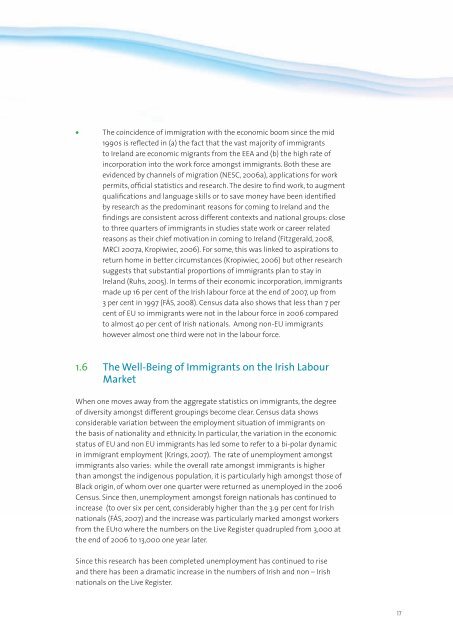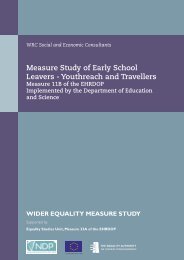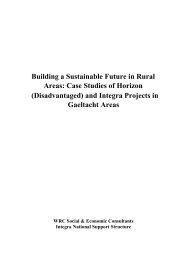Issues and Challenges in the Recruitment and Selection of ...
Issues and Challenges in the Recruitment and Selection of ...
Issues and Challenges in the Recruitment and Selection of ...
You also want an ePaper? Increase the reach of your titles
YUMPU automatically turns print PDFs into web optimized ePapers that Google loves.
• The co<strong>in</strong>cidence <strong>of</strong> immigration with <strong>the</strong> economic boom s<strong>in</strong>ce <strong>the</strong> mid1990s is reflected <strong>in</strong> (a) <strong>the</strong> fact that <strong>the</strong> vast majority <strong>of</strong> immigrantsto Irel<strong>and</strong> are economic migrants from <strong>the</strong> EEA <strong>and</strong> (b) <strong>the</strong> high rate <strong>of</strong><strong>in</strong>corporation <strong>in</strong>to <strong>the</strong> work force amongst immigrants. Both <strong>the</strong>se areevidenced by channels <strong>of</strong> migration (NESC, 2006a), applications for workpermits, <strong>of</strong>ficial statistics <strong>and</strong> research. The desire to f<strong>in</strong>d work, to augmentqualifications <strong>and</strong> language skills or to save money have been identifiedby research as <strong>the</strong> predom<strong>in</strong>ant reasons for com<strong>in</strong>g to Irel<strong>and</strong> <strong>and</strong> <strong>the</strong>f<strong>in</strong>d<strong>in</strong>gs are consistent across different contexts <strong>and</strong> national groups: closeto three quarters <strong>of</strong> immigrants <strong>in</strong> studies state work or career relatedreasons as <strong>the</strong>ir chief motivation <strong>in</strong> com<strong>in</strong>g to Irel<strong>and</strong> (Fitzgerald, 2008,MRCI 2007a, Kropiwiec, 2006). For some, this was l<strong>in</strong>ked to aspirations toreturn home <strong>in</strong> better circumstances (Kropiwiec, 2006) but o<strong>the</strong>r researchsuggests that substantial proportions <strong>of</strong> immigrants plan to stay <strong>in</strong>Irel<strong>and</strong> (Ruhs, 2005). In terms <strong>of</strong> <strong>the</strong>ir economic <strong>in</strong>corporation, immigrantsmade up 16 per cent <strong>of</strong> <strong>the</strong> Irish labour force at <strong>the</strong> end <strong>of</strong> 2007, up from3 per cent <strong>in</strong> 1997 (FÁS, 2008). Census data also shows that less than 7 percent <strong>of</strong> EU 10 immigrants were not <strong>in</strong> <strong>the</strong> labour force <strong>in</strong> 2006 comparedto almost 40 per cent <strong>of</strong> Irish nationals. Among non-EU immigrantshowever almost one third were not <strong>in</strong> <strong>the</strong> labour force.1.6 The Well-Be<strong>in</strong>g <strong>of</strong> Immigrants on <strong>the</strong> Irish LabourMarketWhen one moves away from <strong>the</strong> aggregate statistics on immigrants, <strong>the</strong> degree<strong>of</strong> diversity amongst different group<strong>in</strong>gs become clear. Census data showsconsiderable variation between <strong>the</strong> employment situation <strong>of</strong> immigrants on<strong>the</strong> basis <strong>of</strong> nationality <strong>and</strong> ethnicity. In particular, <strong>the</strong> variation <strong>in</strong> <strong>the</strong> economicstatus <strong>of</strong> EU <strong>and</strong> non EU immigrants has led some to refer to a bi-polar dynamic<strong>in</strong> immigrant employment (Kr<strong>in</strong>gs, 2007). The rate <strong>of</strong> unemployment amongstimmigrants also varies: while <strong>the</strong> overall rate amongst immigrants is higherthan amongst <strong>the</strong> <strong>in</strong>digenous population, it is particularly high amongst those <strong>of</strong>Black orig<strong>in</strong>, <strong>of</strong> whom over one quarter were returned as unemployed <strong>in</strong> <strong>the</strong> 2006Census. S<strong>in</strong>ce <strong>the</strong>n, unemployment amongst foreign nationals has cont<strong>in</strong>ued to<strong>in</strong>crease (to over six per cent, considerably higher than <strong>the</strong> 3.9 per cent for Irishnationals (FÁS, 2007) <strong>and</strong> <strong>the</strong> <strong>in</strong>crease was particularly marked amongst workersfrom <strong>the</strong> EU10 where <strong>the</strong> numbers on <strong>the</strong> Live Register quadrupled from 3,000 at<strong>the</strong> end <strong>of</strong> 2006 to 13,000 one year later.S<strong>in</strong>ce this research has been completed unemployment has cont<strong>in</strong>ued to rise<strong>and</strong> <strong>the</strong>re has been a dramatic <strong>in</strong>crease <strong>in</strong> <strong>the</strong> numbers <strong>of</strong> Irish <strong>and</strong> non – Irishnationals on <strong>the</strong> Live Register.17




